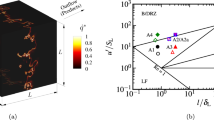Abstract
In this study, a 3-D CFD simulation and laser diagnostics were developed to understand the characteristics of soot generation in a diesel diffusion flame. The recently developed RANS (Reynolds-averaged Navier-Stokes equations) hybrid combustion model (Extended Coherent Flame Model — 3 Zones, ECFM-3Z model) was used. This industrial, state-ofthe-art model of the diffusion flame is commonly used in diesel combustion models as well as for propagating (premixed) flame combustion. The simulation results were validated with measurements from a constant volume combustion chamber. The experiment revealed that soot accumulated in the chamber where the temperature decreased. Where the temperature increased rapidly, only a little soot accumulated. The temperature and soot distribution were independently examined using both the two-color method and a 3-D CFD simulation for a turbulent diesel diffusion flame.
Similar content being viewed by others
Abbreviations
- KL:
-
soot concentration factor
- Ta1, Ta2 :
-
temperature at the 550 nm and 750 nm wavelength
- α:
-
particle size parameter
- c1 :
-
first radiation coefficient
- c2 :
-
second radiation coefficient
- λ:
-
wave length (nm)
- ɛλ :
-
emissivity at wavelength
References
Campbell, J. W. and Gosman, A. D. (2008). Analysis of premix flame and lift-off in diesel spray combustion using multi-dimensional CFD. SAE Paper No. 2008-01-0968.
Chomiak, J. and Karlsson, A. (1996). Flame lift-off in diesel sprays. Proc. Combust. Inst., 26, 2557–2504.
Colin, O. and Benkenida, A. (2004). The 3-zone extended coherent flame model (ECFM3Z) for computing premixed/diffusion combustion. Oil & Gas Science and Technology 59,6, 593–609.
Colin, O. and Pires da Cruz, A. and Jay, S. (2005). Detailed chemistry based auto-ignition model including low temperature phenomena applied to 3D engine calculations. Proc. Combustion Institute.
Han, Y. T., Kim, K. B. and Lee, K. H. (2008). The investigation of soot and temperature distributions in a visualized direct injection diesel engine using laser diagnostics. Meas. Sci. Tech. 19,11, 1–11.
Han, Y. T., Lee, K. H. and Min, K. D. (2008). A Study on the measurement of temperature and soot in a constantvolume chamber and a visualized diesel engine using the two-color method. J. Mech. Sci. Tech., 22, 1537–1543.
Han, Y. T., Lee, K. H. and Min, K. D. (2009). A study on the measurement of temperature and soot in a constantvolume chamber and a visualized diesel engine using the two-color method. J. Mechanical Science and Technology 23,11, 3114–3123.
Karlsson, A., Magnusson, I., Balthasar, M. and Mauss, F. (1998). Simulation of soot formation under diesel engine conditions using a detailed kinetic soot model. SAE Paper No. 981022.
Kim, M. S. (2003). Development of Diesel Spray Model in Consideration of Cavitation and Spray Impingement. Ph. D. Dissertation. Seoul National University. Korea.
Lyn, Y. T. (1957). Diesel combustion study by infrared emission spectroscopy. J. Inst. Petrol, 43, 25.
Magnussen, B. F. and Hjertager, B. W. (1981). On the structure of turbulence and a generalised eddy dissipation concept for chemical reaction in turbulent flow. 19th AIAA Aerospace Meeting, St. Louis, USA.
Matsui, Y., Kaminoto, T. and Matruoka, S. (1979). A study on the flame temperature and soot concentration in a D.I. diesel engine by the two-color method. SAE Paper No. 790491.
Nam, Y. W. and Lee, W. (2004). The measurement of soot particle temperatures using a ratio pyrometry. KOSCO Symp.
Reitz, R. D. (1978). Atomization and Other Breakup Regimes of Liquid Jet. Ph. D. Dissertation. Princeton University. USA.
Reitz, R. D. and Diwakar, R. (1986). Effect of drop breakup on fuel sprays. SAE Paper No. 860469.
Reitz, R. D. and Hampson, G. J. (1998). Two-color imaging of in-cylinder soot concentration and temperature in a heavy-duty D.I. diesel engine with comparison to multidimensional modeling for single and split injection. SAE Paper No. 980524.
STAR-CD (2005). STAR-CD Ver 3.26 Methodology. STAR-CD. London.
Vattulainen, J., Nummela, V., Hernberg, R. and Kytola, J. (2000). A system for quantitative imaging diagnostics and its application to pyrometric in-cylinder flametemperature measurements in large diesel engines. Meas. Sci. Tech., 11, 103–119.
Yamaguchi, I. and Nakahira, T., Komori, M. and Kobayashi, S. (1990). An image analysis of high speed combustion photographs for D.I. diesel engine with high pressure fuel injection. SAE Paper No. 901577.
Zhao, H. and Broughton, F. (1998). Optical diagnostics for soot and temperature measurement in diesel engines. Prog. Energy Combust. Sci., 24, 221–225.
Author information
Authors and Affiliations
Corresponding author
Rights and permissions
About this article
Cite this article
Han, Y., Park, W. & Min, K. Soot and temperature distribution in a diesel diffusion flame: 3-D CFD simulation and measurement with laser diagnostics. Int.J Automot. Technol. 12, 21–28 (2011). https://doi.org/10.1007/s12239-011-0003-2
Received:
Revised:
Published:
Issue Date:
DOI: https://doi.org/10.1007/s12239-011-0003-2




